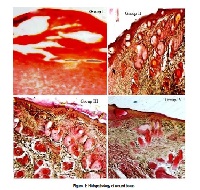Evaluations of healing potential of ethanol extract from Macrothelypteris torresiana (Gaudich) aerial parts
Keywords:
Macrothelypteris torresiana, Excision and incision wound model, Dead space wound model, Histological studies, Chemical and thermal burn, Povidone-iodine, Silver sulfadiazine, Simple ointmentAbstract
The aim of the present study is to evaluate healing potential of 5% and 10% (w/w) ethanol extract from Macrothelypteris torresiana aerial parts (EEMTAP) in simple ointment (family thelypteridaceae). In excision wound model the ethanol extract from M. torresiana aerial parts showed significant increase in percentage wound closure and increased rate of epithelization. In incision wound model, EEMTAP treated animals showed increase in breaking strength when compared with control group. Similarly, the efficacy of treatment of chemical and thermal burn injuries in rats showed significant reduction in the burn wound area when compared with control group animals. These results showed that the burn wounds of untreated groups were contaminated, as they were not repaired, while those of treated groups by silver sulfadiazine and EEMTAP restored the normal architecture more rapidly and the percentage wound closure time was significantly reduced. In dead space wound model the ethanol extract treated animals (200 mg/kg, p.o.) showed significant increase in both wet and dry weight of granulation tissue. Estimation of hydroxyproline content in the granulation tissue revealed that the animal groups treated with EEMTAP had high hydroxyproline content as against the control group. The histological studies of the wound tissues revealed that the granulation tissue of the control group of animals showed more aggregation of macrophages with few collagen fibers, persistent inflammation, oedema and with chronic inflammation. In the case of povidone iodine treated animal possess significant increase in collagen deposition showing lesser macrophages with granulation tissue formation and lesser fibroblasts. In the case of 5% (w/w) EEMTAP treated animals revealed that moderate collagen deposition, macrophages and fibroblasts were noticed and the wounds treated with 10% (w/w) EEMTAP in simple ointment showing significant increased collagenation, few macrophages and capillaries.
References
. Bostock PD. Thelypteridaceae: Flora of Australia. Australia: Australian Biological Resources Study/CSIRO Publishing; 1998. 327-358.
. Short PS. A review of ferns and fern allies of the northern territory. The Beagle, records of the museums and art galleries of the northern territory. 2003; 19: 7-80.
. Chen J, Lei Y, Wu G, Zhang Y, Fu W, Xiong C, Ruan J. Renoprotective potential of Macrothelypteris torresiana via ameliorating oxidative stress and proinflammatory cytokines. Journal of Ethnopharmacol. 2012; 139(1): 207-13.
. Huang XH, Xiong PC, Xiong CM, Cai YL, Wei AH, Wang JP, Liang XF, Ruan JL. In vitro and in vivo antitumor activity of Macrothelypteris torresiana and its acute/sub-acute oral toxicity. Phytomedicine. 2010; 17(12): 930-934.
. Ying Tang, Wei Fang, Yun Tao Ma, Ya Ling Cai, Jin Lan Ruan. A novel flavonoid from the root of Macrothelypteris torresiana (Gaud.) Ching. Chinese Chemical Letters. 2009; 20(7): 815–816.
. Wei Fang, Jinlan Ruana, Yaling Cai, Anhua Wei, Daonian Zhou, Wenting Zhang. Flavonoids from the aerial parts of Macrothelypteris torresiana. Natural Product Research. 2011; 25(1): 36-39.
. Harborne JB. Phytochemical Methods: A Guide to Modern techniques of Plant analysis. New York: Chapman and Hall; 1984. p. 37-214.
. Kokate CK. Practical Pharmacognosy. 4th ed. Delhi, India: Vallabh Prakashan; 1994: p. 107.
. OECD/OCDE, OECD Guidelines for the testing of chemicals, revised draft guidelines 423: Acute Oral toxicity- Acute toxic class method, revised document, CPCSEA, Ministry of Social Justice and Empowerment, Govt. of India; 2000.
. Morton JJ, Malone MH. Evaluation of vulnerary activity by open wound procedure in rats. Arch Int Pharmacodyn Ther. 1972; 196: 117-120.
. Kamath JV, Rana AC, Chowdhury AR. Prohealing effect of Cinnamomum zeylanicum bark. Phytother Res. 2003; 17: 970-972.
. Lowry OH, Rosenbrough NJ, Farr AL, Randall BJ. Protein measurement. J Biol Chem. 1951; 193: 265-275.
. Fulzele SV, Satturwar PM, Joshi SB, Dorle AK. Wound healing activity of Chandanadi yamak in Rats. Ind J Pharm Sci. 2003; 65 (3): 301-304.
. Ehrlich HP, Hunt TK. Effect of cortisone and vitamin A on wound healing. Ann Surg 1968; 167: 324-328.
. Umachigi SP, Jayaveera KN, Ashok Kumar CK, Kumar GS, Vrushabendra Swamy BM, Kishore Kumar DV. Studies on Wound Healing Properties of Quercus infectoria. Tropical J Pharm Res. 2008; 7 (1): 913-919.
. Sheeba M, Emmanuel S, Revathi K, Ignacimuthu S. Wound healing activity of Cassia occidentalis L. in albino Wistar rats. International Journal of Integrative Biology. 2009; 8(1): 1-6.
. Krishna Murti, Upendra Kumar. Enhancement of wound healing with roots of Ficus racemosa L. in albino rats. Asian Pacific Journal of Tropical Biomedicine. 2012; 2(4): 276-280.
. Krishna Murti, Upendra Kumar. Enhancement of wound healing with roots of Ficus racemosa L. in albino rats. Asia Pasific Journal of Tropical Biomedicine. 2012; 2(4): 276-280.
. Pradhan D, Panda PK, Tripathy G. Wound Healing activity of aqueous and methanolic bark extracts of Vernonia arborea Buch.-Ham. In Wistar rats. Natural Product Radiance. 2009; 8(1): 6-11.
. Osama A. Abu-Zinadah. Effects of Watercress oil on thermal and chemical burn injuries in rabbits. Journal of King Abdulaziz University-Medical Sciences. 2008; 15(4): 3-17.
. Zarghami Moghaddam P, Zolfaghari MR, Ghaemi EA, Mazandarani M, Mansourian AR, Taheri SA. Negative Performance of Root Extract of Onosma dichroanthum Boiss. on the Burn Wound Healing in an Animal Model. Arch. Clin. Microbial. 2011; 2(5): 3823-3838.
. Madhura MR, Sushma AM. Comparative effect of oral administration and topical application of alcoholic extracts of Terminalia arjuna bark of incision and excision wounds in rats. Fitoterapia. 2003; 74: 553-558.



